#proto hand tools
Text
PROTO hand tools offer precision and reliability for industrial and automotive needs. Crafted with durability and accuracy in mind, these tools are trusted by professionals worldwide. From wrenches to sockets, each tool is engineered to deliver exceptional performance, making PROTO the go-to choice for precision work in demanding environments.
0 notes
Text
The Finest Hand Tools For Every Task
In Today's Fast-Paced World, Where Efficiency And Precision Are Paramount, Having The Right Tools At Your Disposal Can Make All The Difference. Hand Tools Are Vital In Various Industries, From Construction And Automotive Repair To Woodworking And Metalworking. This Blog Post Will Analyze Three Renowned Brands Known For Their Exceptional Quality And Reliability: PROTO Hand Tools, Expert By FACOM Hand Tools, And Ingersoll Rand Tools. So, Let's Take A Closer Look At What Sets Them Apart And How They Can Enhance Your Workmanship.
PROTO Hand Tools: Precision And Durability In Every Detail
Professionals Have Trusted PROTO Hand Tools For Over A Century. The Brand Prides Itself On Its Commitment To Excellence, Consistently Delivering Top-Notch Tools That Withstand The Test Of Time. Whether You're A Mechanic, Plumber, Electrician, Or General Contractor, PROTO Offers A Comprehensive Range Of Tools Catering To Your Needs.
One Of The Key Features Of PROTO Hand Tools Is Their Exceptional Durability. Crafted From High-Quality Materials Such As Chrome Vanadium Steel, PROTO Tools Are Designed To Withstand Rigorous Use And Demanding Work Environments. The Brand's Commitment To Precision Engineering Ensures That Each Tool Meets The Highest Standards Of Accuracy, Providing You With Consistent And Reliable Performance.
Expert By FACOM Hand Tools: Unleash Your Expertise
Expert By FACOM Is Renowned For Its Exceptional Craftsmanship And Meticulous Attention To Detail. With A Strong Focus On Ergonomics And Functionality, Expert By FACOM Hand Tools Is Designed To Empower Professionals And Enhance Their Craft.
One Notable Aspect Of Expert By FACOM Hand Tools Is Their Innovative Design. The Brand Incorporates User Feedback And Extensive Research To Develop Tools That Offer Optimal Comfort And Efficiency. From Wrenches And Screwdrivers To Socket Sets And Pliers, Expert By FACOM's Extensive Product Line Covers A Wide Range Of Applications, Ensuring That Professionals Have The Right Tool For Any Task. Expert by FACOM Hand Tools
Ingersoll Rand Tools: Power And Performance
Ingersoll Rand Tools Is Synonymous With Power, Performance, And Innovation. With A Legacy Of Over A Century, The Brand Has Consistently Pushed The Boundaries Of Tool Engineering. Ingersoll Rand Tools Are Designed To Tackle The Toughest Challenges In The Construction, Manufacturing, And Automotive Industries.
What Sets Ingersoll Rand Tools Apart Is Their Relentless Pursuit Of Innovation. The Brand Consistently Introduces Cutting-Edge Technologies To Improve Productivity And Efficiency. From Impact Wrenches And Drills To Air Compressors And Pneumatic Tools, Ingersoll Rand Offers A Wide Array Of Tools That Deliver Unparalleled Performance And Reliability.
Conclusion:
Non Sparking Tools When It Comes To Hand Tools, PROTO, Expert By FACOM, And Ingersoll Rand Are Renowned Brands That Professionals Rely On For Their Exceptional Quality, Precision, And Durability. Whether You're A Seasoned Craftsman Or A DIY Enthusiast, Investing In Reliable Tools Is Crucial For Achieving Optimal Results.
#proto hand tools#expert by facom hand tools#stanley proto hand tool#work benches vices and workshop furniture#aerospace & rfid tool control#non sparking & sparkless tools#pneumatic impact tools dubai#impact and hand sockets dubai#ingersoll rand pneumatic solutions dubai#pneumatic impact tools port harcourt
0 notes
Note
Max I have a linguistics question. And I will even free your chess ask from purgatory as payment. So there's this thing that goes around saying that US English pronunciations are more similar to old English than British English. Is there any truth to this, and how would we know one way or the other?
There is some kernel of truth in it that is getting exaggerated or oversimplified.
Let me start off by answering, in a general sense, the question "how would we know one way or the other?"
The Part Where I Accidentally (on Purpose) Wrote a Brief Introduction to Historical Linguistics
Phonological change (change in the pronunciation of a language) doesn't work in the way we might naively expect it to. I think that most people imagine phonological change as basically happening by way of each word in the language taking a random walk through pronunciation-space as time goes along. Like genes in a genome, randomly mutating. This is not what happens. Rather, phonological change occurs via rewrite rules, which find-and-replace particular sequences of sounds in a systematic way across the entire lexicon. For example, such a rule might replace a [t] sound with an [s] sound whenever it precedes an [i] sound. This will occur in all words in the language at once, in a uniform way. These find-and-replace rules are called regular sound changes, and they pile up over time, constituting phonological change.
This fact—the regularity of sound change—is known as the Neogrammarian hypothesis.
The above picture is an oversimplification. There are a variety of exceptions and apparent-exceptions to the regularity of sound change, and dealing with them is one of the major challenges of historical linguistics. But as a model, the Neogrammarian hypothesis is extraordinarily powerful. It is literally what makes historical linguistics possible at all. The upshot of the Neogrammarian hypothesis is that when two languages are related, their vocabulary won't just be "kinda similar" in some nebulous sense, it will demonstrate systematic, predictable correspondences in sound between cognate vocabulary.
Here's an illustration of this, a comparative table of some cognates in Polynesian (from Wikipedia):
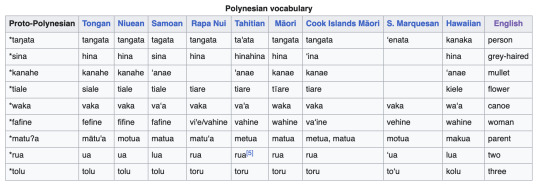
If you look at any two columns of this table, you'll start to notice correspondences. Tongan and Niuean /k/ correspond to Samoan /ʔ/ (a glottal stop, written with a apostrophe). This correspondence is one-to-one. Samoan /s/ corresponds to Tongan and Niuean /h/, but the reverse is not true: some instances of Tongan and Niuean /h/ correspond to Samoan ∅ (nothing). Tongan /s/, on the other hand, corresponds to Niuean and Samoan /t/, but only before /i/. Etc. etc.
These are systematic sound correspondences, born of Neogrammarian sound change from a common ancestor.
Ok, on the left hand side you will notice a column that says "Proto-Polynesian". The words in this column are all marked with *, indicating that they are reconstructed forms. They are linguists' best guess as to what the original, ancestral form of these words would have been in the Polynesian languages' common ancestor. There are various ways linguists make these reconstructions. First of all, we can do it by sheer majority rule: if most of the languages in a family reflect a sound as X, and only one or a few reflect it as Y, then (all else being equal and assuming the tree is flat) it is more likely that the original word had X. Almost all these languages have /t/ as the first sound in "person" (row 1), whereas Marquesan has /ʔ/ and Hawaiian has /k/. Thus the ancestral sound is reconstructed as /t/.
But there are other, more sophisticated tools that can be used. For instance, we know a certain amount about what sorts of sound changes are likely to occur and what sorts are not. Thus, for instance, an /s/ is reconstructed as the first sound in "grey haired" (row 2), even though the majority of languages have /h/. This is because we already know that s -> h is a fairly common sound change (and indeed corresponds to a known phonological process found presently in many languages—debuccalization), whereas h -> s is a much rarer change (in fact, I suspect wholly unattested), and corresponds to no known phonological process or phonetic explanation.
Finally, we can rule out reconstructions when the sound change needed to create them would not be a function. Consider, for instance, that the majority of the words in row 3 have no consonant sound at all before the final /e/. But the reconstruction features a consonant /h/ there. If we posit ∅ as initial instead, we have to come up with a sound change that explains how the /h/ got there. ∅ -> h doesn't work, because that would put /h/ everywhere! How about something like "∅ -> h between two vowels" (linguists would notate this change as ∅ -> h / V_V). That would work, but we see other instances of adjacent vowels (e.g. in row 4) with no /h/ between them, so that can't be it. Maybe "∅ -> h between /a/ and /e/" (∅ -> h / a_e). We can't rule this out on the basis of this chart, but we probably could by looking at more vocabulary.
And so on, and so forth. In general, we want to posit the simplest set of sound changes possible, in which the changes themselves are as probable as possible, in order to explain the data. These putative changes can then by checked against all sorts of outside observations, such as
descriptions of pronunciations in historical texts
past loanwords into languages whose phonological histories are already known with confidence
epigraphic data from archeology (not very applicable to Polynesian, unless we decipher rongorongo)
newly collected data from modern languages in the same family
evidence from rhyme schemes or alliteration schemes used in poetry composed in the past
etc.
to see if they hold up.
The Part Where I Answer Your Question
Ok, right. American English and "British English" (I assume this means Received Pronunciation) are two related language varieties. Thus, they share systematic sound correspondences, and we can try to reconstruct their common ancestor. Also the British Isles have produced an extraordinary number of texts in the past thousand years, including poetry and actual linguistic descriptions of various dialects at various points in time, which we can check these reconstructions against.
But actually you don't need most of that to identify a few ways in which (most) American English dialects are more conservative than Received Pronunciation. For one, Received Pronunciation has dropped /r/ at the end of a syllable (in English dialectological jargon it is "non-rhotic"), whereas General American English hasn't. There are some associated vowel changes too. One way or another, the /r/ is plainly original: elision of /r/ is more common and phonetically plausible than insertion of /r/ in a bunch of specific post-vocalic positions would be, /r/ is written in the orthography, historical descriptions of the language talk about an /r/ sound, etc. etc.
In other ways RP is more conservative. For example, GenAm has deleted /j/ (the "y" sound) in a specific phonological environment ([+coronal]_u) in words such as tube, GenAm /tuːb/, RP /tjuːb/.
Is "American English more conservative than RP" overall? I don't really think so. Certainly it has preserved a number of salient features that RP has lost, such as syllable-final /r/ and (in some dialects) /hw/ in words like what, and so on. But there's other senses in which RP is more conservative. And this is not even to mention the other dialects of Britain, which are manifold and much more diverse than the dialects of America. As to the strict question of the relative phonological conservatism of GenAm and RP, I think someone with more detailed knowledge of English historical phonological would have to come in and answer. Perhaps @yeli-renrong can comment.
600 notes
·
View notes
Text
(Note: this is all totally non-rigorous free association)
Famously, the King James Version of the Bible translates Exodus 22:18 as "thou shalt not suffer a witch to live." This is one of those translations, though, that has suffered for passing through multiple different cultural lenses over the textual history of Exodus. Alternate modern translations say things like "put to death any woman who does evil magic," "*wizards* thou shalt not suffer to live," or even "whoever has sexual relations with an animal must be put to death."
In the Septuagint, the underlying word is translated φάρμακος; despite the connotation of the English word, a masculine noun; the word is associated with magical arts in general, but is *especially* associated with poison. It's from φάρμακον, a word which can mean either "poison" or "drug," and is the origin of "pharmacy." Greek had a rich vocabulary for the supernatural: an older and more general word seems to be γοητεία, "charm, jugglery, sorcery," from γόης, "sorcerer, wizard, juggler, cheat." That it includes in its semantic field the concept of sleight-of-hand shows that mundane deception is countenanced as a possible explanation for claims of magical power, which no doubt contributes to the dim social reception of magic, but also shows a neat symmetry with the modern concept of the stage magician, whom we publicly acknowledge as really being just a particular kind of illusionist and entertainer. Another Greek word for magic is, well, μάγος, the source of the English word, ultimately a borrowing from Old Persian maguš. A maguš was simply a priest of Mazda in the old Zoroastrian religion; the word is of uncertain etymology, but its connotations in Greek arise from crediting a Greek mythical version of Zoroaster with the invention of magic and astrology, showing us that perhaps orientalism of one sort or another has long been part of European traditions of the occult. There is also θαυματουργία, "wonder-working, doing miracles, wizardry."
But the Septuagint word choice is an odd one; as I understand it, the actual underlying lexical item is מְכַשֵּׁפָה/mekhashefah, the feminine form of מְכַשֵּׁף/mekhashef. The root of this word seems to be כשף/KH-SH-F, which has been glossed various ways. One gloss I find particularly interesting is "cut." Kenneth Kitchen links this etymology to the cutting of herbs; thus, a mekhashef is a kind of herbalist, and the context, as with pharmakos, is the fear of poisons--the feminine form might also make sense here, as it seems plausible that just as in our modern society, poisoning was a more reliable tool for killing for women than for men, for whom the possibility of physically overpowering their enemies was less likely.
But I think it's interesting to note other ways in which magic is about division and breaking. Though in modern fantasy a "warlock" is either just a generic wicked sorcerer, or a summoner of demons, the word comes from Old English wǣrloga ("promise-deceiver"), a deceiver, a breaker of oaths. A warlock is thus someone who dissolves social ties, or even betrays their baptismal vows by making an unholy vow, an un-promise, to Satan himself. The English "witch" comes from the Old English wiċċa or wiċċe (masculine and feminine forms respectively), from Proto-Germanic *wikkô, "sorcerer, necromancer," from the verb *wikkōną, "to practice sorcery." One likely derivation of *wikkōną is the Proto-Indo-European stem *weyk-, "to separate, to divide, to choose." This may be a reference to cleromancy, the casting of lots; many ancient words for magic link together fortunetelling of various kinds (the second element in words like "necromancy" and "cleromancy" is ancient Greek μᾰντείᾱ, "divination, prophecy, fortune-telling), but here again the concept of separation appears in a way that is difficult to ignore.
The Romans, like the Greeks, looked east for their wisdom, and were also obsessed with divination in particular, so their words for magic are often borrowed from Greek, or concern forms of fortune-telling in particular: haruspicina, the inspection of entrails; the genius or numen, language of spiritual presence and will (the latter not dissimilar to the mana of Polynesia); auspicium, the interpretation of omens, especially the flights of birds. Perhaps other kinds of magic invoked skepticism: Pliny argues that, except possibly in the making of potions (the Romans, no less than the Greeks and the Hebrews, knew that the right herbs could kill!), most claims of magic were simply lies--though there was little harm in apotropaic wards to set the mind at ease. Apuleius granted the existence of spirits and demons, and both Augustus and Constantine worried enough about magic to try to suppress its practice.
In Sanskrit, magic was apparently sometimes called इन्द्रजाल/indrajala, "Indra's net," a metaphor for emptiness, a word that foregrounds the idea of fraud and illusion. Similarly, the word माया/maya means "magic," but also "illusion," being in that way akin to the English notion of glamour found in fairy-stories. There is also possibly semantic overlap with German Zauber, whose meaning is "magic," but which is etymologically connected to Old English tēafor, "to paint [a picture]," and Icelandic töfrar, "enchantment." (Icelandic also has galdur, "sorcery," but also "[conjuring] trick.") Chinese offers the root 魔/mo2, which according to Wiktionary is from Sanskrit मार/mara, "death, pestilence;" in Chinese it takes on theurgic qualities: "devil, demon, magic, the unnatural, crazy," depending on the context it's found in: 魔羅, a kind of Buddhist demon; 魔術, "magic," as in an illusion imitating the supernatural; 瘋魔, "to be insane, to be fascinated by, to be enchanted by," a concept of obsessive madness shared in other cultures, including our own.
A full cross-cultural, historical comparison of words pertaining to magic is far beyond my capabilities, of course; but exploring current in the vocabulary and historical development of words around magic is interesting so far as it peels back the thick systematizing, empirical layer within our culture and helps us glimpse how these ideas functioned in the past. Nowadays, magic is often prototypically the magic of high fantasy: it is systematic, little more than a flashy kind of science, even if it is one accessed through mental discipline rather than mechanical instruments. Magic is patterned, stable, fundamentally knowable, because we are so thoroughly grounded in systems of knowledge that understand the whole world as patterned and knowable that we cannot imagine anything else. We redefine magic in ways that simplify it down to nothing: to be little more than abstract spiritual practice, moral therapeutic deism with countercultural window-dressing, or to mean nothing more than simply acting on the world. But is that really in keeping with the spirit of the thing, as it is has been imagined for most of history?
Magic is about many things. It is about division: discrimination, separation, cutting. Cutting the body of the sacrifice, to prod at its bloody insides; cutting breath from a living victim; cutting off the sacred from the unholy, and vice-versa. It is about speaking, chanting, singing, the form and the performance of words. It is about writing (itself a word which means to cut or carve into something). It is about deception: lies in pursuit of status or money, lies to avoid culpability for murder, lies about secret knowledge. It is about feeling oneself inhabiting a world filled with intentional beings, beings with a will and nature unknown and perhaps unknowable to you. Spirits of the dead, of the air, and of the wild world; the genius loci, the demon, the hungry ghost. It of a world when the night could claim real darkness, when the stars were forever an inscrutable mystery, and when the terrifying unknown could intrude into your life at a moment's notice. Even modern occultism feels like a nonsensical imitation of the past, with emphasis on benign enlightenment or spiritual growth, when ancient magic was rife with murder, curses, treachery, and simple human greed. The huckster fortune-teller, who cynically defrauds their customrs, is closer to the spirit of magic than the observant neo-pagan.
We are mostly too sure of ourselves, and too confident in our ability to understand even that which is at first horrifying and inexplicable, to really replicate the feeling of that kind of magic. A world in which that kind of magic is possible is a world in which the last few centuries of philosophy and epistemology and science are shown to be so profoundly wrong that we are left with nothing but naive superstition and fear. Or else, it is a world where all these basic forms of inquiry that we take for granted simply do not work--because if they did work, we would be back in our own comforting, familiar world, a world of rationalism and enlightenment, albeit perhaps with a few of the phenomenological incidentals changed. I wonder if it is really possibly anymore for us to tell stories in the mode of that older world. With the exception of certain kinds of horror, I don't really know of anything that comes close.
560 notes
·
View notes
Text
RATHGAMES
hey yall! just added community copies for all my games that were falling behind on em, and figured it'd be a good time to go over everything ive released so far!
KATABASIS: after your death, you wash ashore in a sunless, brutalist afterlife. use your emotional baggage from life as weapons and tools as you explore this tangled purgatory and try to find a way to escape.
DISPARATEUM: there are an infinite number of worlds in the Disparateum, and the Named City connects them all. explore a city where museum hallways turn into fractal labyrinths, where outdoor markets are held in dreams, where stories are ruled by a council of dragons, where your internet connection is routed through a giant spider, where mirrors hide cruel secrets.
BXLLET: bullets are precious in the apocalypse, despite everyone's efforts to move on from them. with one bullet, you can decide who lives and who dies. with five, you can unlock strange and alien powers. with twenty, you can rule the world, or wipe it out again.
(ive also got RXLOAD, a love letter to all the fantastic BXLLET supplements written since the game's release, and DXMON, a collaboration with Jon East to adapt BXLLET's mechanics for a Chainsaw Man-inspired setting)
CHARCUTERIE: three zines, each about 40 pages long, each with a heaping handful of small games, writings, doodles, and other projects.
ive also got some smaller projects under the break!
STATIONKEEPING: a small index card game for carrying around in your back pocket. slowly repair a space station as you live your life, and occasionally meet friendly aliens or connect your station to someone else's.
NOT WEAVERDICE: a super small Worm proto-ttrpg. i feel like rigid, strictly-defined point-buy power systems go against the strange, flexible, deeply unfair powersets present in Worm, so i made a short guide to making strange, flexible, deeply unfair powersets fun to play with.
MORTAL POPBAT: a 600-page funko pop wargame. build your army and brutally wipe out your enemy's POP!batants. if you actually play this, let me know so i can point and laugh.
WINTERGREEN: a ttrpg campaign that fits entirely in a mint tin. help a small frigid community in a series of short, interconnected quests.
41 notes
·
View notes
Text
It's that page-filling time again! Weird Phyrexians 14-20! (Sorry for the weird light effect, I couldn't get a good angle on the whole page, so I'm reattaching a better photo of the top two below.)


14: Along the lines of tome lackeys, mites, and other small scurrying Orthodoxy servants, this one was simply made to be a bowl, carrying ichor or other liquids to partake in holy rituals.
15: This wiry creature has wrapped itself in stinking, decaying piles of discarded gore from the Orthodoxy's compleation chambers, topping it all off with a pilfered faceplate. Now, it wanders the rare dark corners of the Basilica looking for more flesh to add to its hoard.
16: Combination survey instrument and grappling hook, this Progress Engine device is used for detaining unwanted intruders. It features a prominent eye in the center, with its optic nerve wrapping up along the tentacle "arm". Smaller nerve bundles connect the eyes on the three claws to the center.
17: It's not too clear what this soft and goopy creature actually is, as it's a shy, quaking thing that's cloistered itself in the toughest shell it can find and added spikes and teeth to scare off others from investigating. Unfortunately, the ichorous tear trails it leaves behind make it easy to track. The poor thing has anxiety.
18: A helpful tool assistant from the Quiet Furnace, complete with tiny arms to hand off supplies to busy artisans.
19: This skite was of plot relevance in the New Phyrexia campaign I DM. It sucks up oil through its syringe and processes it in its abdomen, before the bulbs on its body change color to indicate the oil's mana affinity. It's how a core-born Swarm PC learned that she was in fact of Gitaxian descent.
20: Like a proto-Dominus, this being coalesced as an avatar of faith... but not the kind the Orthodoxy likes. Despite being white-mana-aligned, it shows itself to be something of a free spirit, and represents the faith of Phyrexians in themselves. This is deeply inconvenient to the Orthodoxy.
68 notes
·
View notes
Text
Guys I think should be in MOTU: Origins
My love of MOTU Origins is not very hidden, and they've hit tons of great points, but there's so much further to go. So, here's my rundown of what I'd want to see joint the MOTU Origins lineup.
Section 1: Give it the Sun-Man Treatment.
Blackstar

The proto-He-Man of yore, Blackstar as an IP is probably well within the price range for Mattel to sweep up to sprinkle into the line the same way Sun Man's universe was.


For advantages, it's VERY aesthetically compatible and has several strong character designs. It's no more obscure than Sun-Man, and I want hordes of those imp-demons, damnit.
BraveStarr

Again, a no-brainer. Find the character rights holders, get the rights. New Texas is out there in space, use it as an excuse to do MOTU:Origins versions of the New Adventures designs ("space travel" He-Man) and Rio-Blast. If they already own all the rights then them not having already done this is toyetic malpractice.


Advantages are obvious. BraveStarr rocks. You have a POC lead hero, Tex-Frickin'-Hex, and Thirty-Thirty, who would be well worth the extra tooling to make a deluxe figure of (you can always do an upgraded Stridor repaint). You would scatter them through waves to keep from overloading with the Space Cowboy thing, but def a winner.
Also, Rio-Blast. Rio-Blast, Yo.
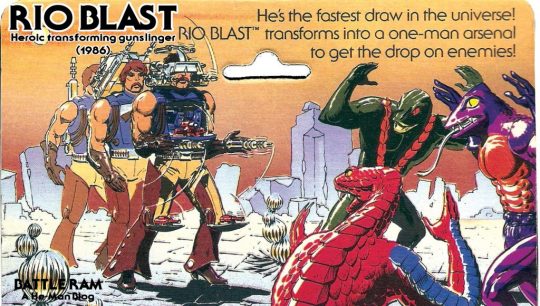
Skeleton Warriors
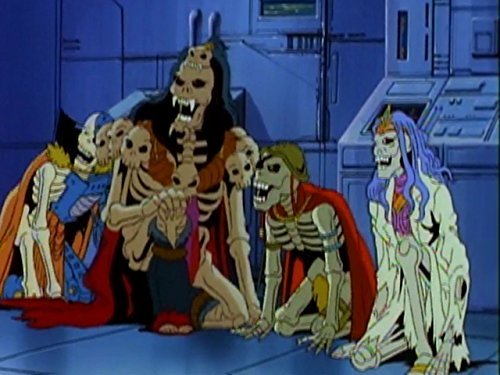
It was never strong enough to stand on its own. Give Skeletor some friends. 'Nuff Said.
One-Off Guest Stars
This section is a little different, as these wouldn't be permanent integrations, but more fun crossover one-offs rather than being a whole theme. Characters pulled from other Mattel-owned lines of the past:
Mojo Ken and Thunderpunch Barb-E


Here's the thing. This line is dead stupid, and should remain that way. Give Ken two heads (one 'bad' Mojo head and one 80s toy Ken style one) give Barbie weirdly plausible MOTU gear, the joke alone is worth the parts reuse. Best if nestled in with some Princess of Power characters.
Lets give Captain Power a hand, folks.

Its that live action TV show that interacted with the vehicles that landed in the uncanny valley between family TV and advert-traintment that never quite works!
Captain Power and Lord Dread are pretty much the only ones you'd want to hit, maybe the Soaron Sky Sentry. And really, they're not that hard to do. Captain Power could easily be made with Roboto legs and upper arms, any number of gloved hands, a new chest armor and a new head.
Any newly tooled pieces would be useful in MOTU movie and new adventure characters.
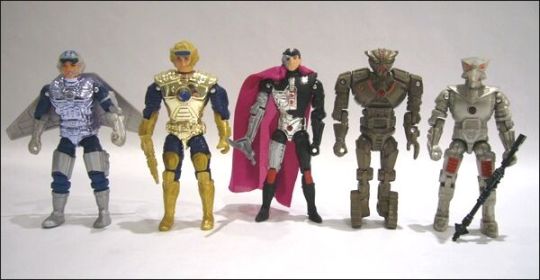
The Construx Alien demands your respect.

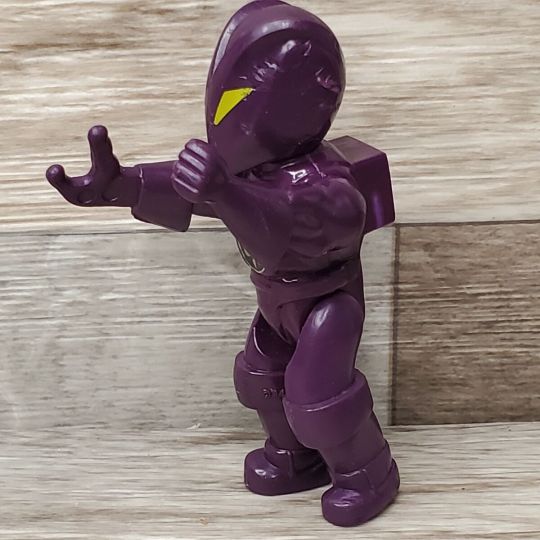
I know it makes no sense, I don't care, it's my list. He's amazing and needs to be big and buff with a weird hand.
Major Matt Mason has nothing better to do.


This set's a stretch, as it would require a chunk of new tooling, but again, maybe worth it for the New Adventures and She-Ra applications, plus hey, Astronaut prequel Biff Bestman, Evelyn Powers, and Captain Marlena parts!
He-Man's space-man friend is a role that could still be filled.
Next Up... Crossover Potential.
#my druthers#mattel#he-man#masters of the universe origins#motu#major matt mason#skeleton warriors#captain power#barbie#ken#bravestarr#blackstar
27 notes
·
View notes
Note
Do you think redirecting my MADD (Mal-Adaptive Daydreaming Disorder) to create a Tulpa might work?
Meditation is difficult because I live with a lot of noisy people and animals, and my MADD already makes me more likely to stop what I'm doing and go on an imaginary rant about stuff - do you think this might help?
(I know it'd probably be way slower than conventional means, but still, y'know?)
Heyo! So this is actually a completely viable method long as you're careful, as lots of neuronarrators end up feeling like their paras are actually conscious after a lotta interaction. If you set up the beginning concepts of your tulpa within your paracosm and let em develop while using tulpamancy guides as a guideline, it'd probably work similarly to how a lotta tulpamancers start off by spending a lotta time in their headspace with their tulpa. When I was super "young" I loved just getting the choice on where I wanna move around and what I wanna explore. I bet a paracosm would be super awesome for a new tulpa just getting their bearings!
MaDD IS something that causes distress or dysfunction, tho, so make sure to remember a few things: for one, try and keep your proto-tulpa away from any disturbing or traumatizing things that could be in your paracosm- it really sucks to have avoidable trauma mixed into your creation, so if your paracosm is super unsafe, not a good idea to create a tulpa in there. On the OTHER hand, I know a lot of paras and sometimes paratives too are totally unaware there's a world outside of their paracosm, but I'm gonna go ahead and say it's Not Really Cool to intentionally do that to a tulpa. Don't keep them trapped in ur paracosm, or try and convince them it's their only place, or try and keep them from being aware of the outside world in any way. DON'T TRUMAN SHOW YOUR TULPAS, I think that's pretty obvious.
Ummm other than that I'd say you know your disorder best! Daydreams can totally be a tool for a tulpa to give em a lot to do out of front, as well as an innerworld identity, which can be really nice! But be super careful not to put them in danger or treat them like unconscious entities like paras or NPCs. Hope that sums it up!
#tulpamancy#pluralgang#tulpa#endogenic#neuronarration#MaDD#maladaptive daydreaming#tulpamancy advice
24 notes
·
View notes
Text
people in the dustloop space are looking into Guilty Gear X more after all these years since ML's getting some attention, and it's shitty in a much similar way but in more of a proto-XX to +R way rather than being toe to tip rotten a little like ML is
specifically though i'd like to share some things about GGX Anji
first off, i'll assume readers are somewhat familiar with GGACR Anji's gameplan and mechanics. if not, short description: solid but specialized normals, consistent okizeme, Autoguard/Guardpoint on specific normals that either blocks strikes that hit High and Mid (High GP) or strikes that hit Low (Low GP) for a specific, usually single-digit, burst of frames; and belligerent defense and a way of consistently "getting in" that is colloquially considered "toddler-accessible". (mainly through H Fuujin being an advancing, extremely long range 1f invuln pseudoreversal that goes into mixup OR combo followups on hit or block)
that and a little skim of the DL page should get you well prepped for this iteration of our boy! this character makes people explode off of grounded mids and doesn't have a full gameplan yet.

first off, your normal that matters: anji isn't proximityless in this game, and c.S is your button. when FDC'd (an exploit-mechanic exclusive to GGX, where you kara cancel a sweep which you gatling into from another normal into FD to functionally instantly cut said normal's remaining active and recovery frames to zero, leaving you neutral and usually Plus A Lot), this move infinites into itself by doing a couple FDC ones in a row, doing an FDC microdash, and repeating.
yes, this hurts your hands (especially considering the Sweep input in GGX was 2S+H, as the D button didn't exist yet). it also has jab pushback, so even if you can't hit the FDC, doing c.S > c.SxN will crank guard bars while beating mash, jump, and usually recovering fast enough for you to catch their backdash (often with another c.S).

5H has autoguard because, like... whatever, sure. the move property was new. live a little. this does make it a reversal that beats meaties, and notably if you're pressing 4H on wakeup, this is an extremely belligerent, obnoxious, and easy option from throw OS since it will stick people in autoguard-stop until it's active if they're hitting you out of throw range and result in you getting wakeup thrown if not. only really loses to spaced lows and projectiles. good ass guilty gear.
Dust, however, tragically lacks autoguard, leaving 5D autoguard > Kou to not be an option anymore, alas. you do have your 6P, though, which uh-

huh
so, that's your overhead animation, with... randomly generated hurtbox shift frames, and it has high guardpoint at an entirely arbitrary (and mostly entirely useless) window. i guess it's uh... harder to challenge, though you still need RC to do anything with it. quite a move.
aside from that, his 3K is on his 6K, and both the tyrant 6K and 6H have f1 High guardpoint, but this creates an unfortunate lack of any low autoguard in Anji's kit, which is a significant thing to have, and prevents Anji - lacking any Low Crush options in his kit, in this state - from dealing with lows much of anywhere, and especially makes him unable to compete with strong sweeps and low profile moves, which he already has trouble with even in +R, where he's a much more complete character.
but hey, that's just buttons. how's butterfly?

...alright! so, meterless Shitsu is FB shitsu. neat. this lets Anji set up meterless high/low unblockables assuming he gets oki instead of just Raohing them. so that's neat. it is still butterfly, though, so it's not good at zoning, contesting projectiles, or pressure outside of okizeme. so uh... guess he can keep it.
Fuujin's the same, mainly, but you can't go into followups on whiff, and the H version has significantly shorter invuln, which... is a pretty big hurt considering the lack of other tools Fuujin could've compensated for. if nothing else, Anji can still play favorable RPS when the opponent blocks Fuujin, so-

oh. hm, that move's mainly only good because you can airdash after it to pressure re-buy. otherwise that's kind of just a slow air backdash that resets you to full screen probably, uh...

hey why are YOU here
(of note, this move is usually used as an air combo knockdown ender. and it still exists in GGX anji's kit, largely untouched. InvisibleWater describes this move as "Probably one of the worst moves I've seen that isn't some 'Oops, we forgot about our own juggle rules' followup".
it's an overhead that's minus a billion on block, gives a bad knockdown on hit, is slow, and doesn't combo from or into anything unlike the great move that's usually the overhead followup out of fuujin as Rin. FB rin is also missing, notably crippling metered options and options in general as Anji.
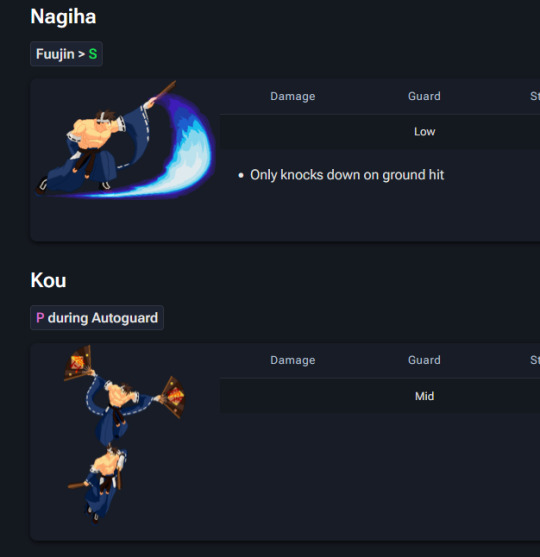
but hey, Nagiha's here and... it can't be used as a surrogate combo ender in the place of other missing tools... and uh... oh, there's no H followup, so we also don't have Hop, the usual K followup. so, uh... hm. that's pretty bad. Kou is probably still good, though...
but that's most of what i wanted to say about GGX Anji! everyone that's been contributing to this game, linking old arcade tournament vods for it, and generally doing their best to explore an otherwise written off entry is super cool. hope you enjoyed reading.
13 notes
·
View notes
Text
Unlock Precision with Proto Hand Tools: A Toolbox Essential

In the realm of craftsmanship, having the proper equipment at your disposal is paramount. Proto Hand Tools stand as a beacon of excellence, imparting unparalleled precision and sturdiness to increase your work to new heights.
Precision Redefined
Proto Hand Tools are crafted with meticulous interest in detail, embodying the essence of precision. From wrenches to screwdrivers, every device is engineered to supply correct results, making every venture a seamless endeavor. Whether you are an expert tradesperson or a DIY enthusiast, Proto Hand Tools redefines precision in the toolbox.
Durability Beyond Compare
A toolbox essential should not only be precise but also endure the rigors of demanding tasks. Proto Hand Tools boast a strong design, constructed with high-quality substances to face up to the test of time. From heavy-duty construction sites to difficult domestic projects, this equipment ensures durability and reliability.
Versatility Unleashed
Proto Hand Tools offers a comprehensive range, catering to diverse needs and applications. Whether it’s automotive repairs, carpentry, or general maintenance, Proto provides a versatile toolkit. Embrace the flexibility these tools afford, allowing you to tackle various projects with confidence and ease.
Invest in Excellence
Choosing Proto Hand Tools is an investment in excellence. Elevate your craft by way of incorporating this equipment into your toolbox, experiencing the ideal combo of precision, durability, and versatility. Embrace excellence, and let Proto Hand Tools end up your depended-on companions in the pursuit of the most reliable craftsmanship.
0 notes
Text
Facom Tools: Unleashing Expertise And Precision In Every Application
In the vast realm of tools and equipment, FACOM is a beacon of excellence and innovation. With a rich heritage spanning several decades, FACOM has consistently delivered cutting-edge solutions to meet the evolving needs of professionals across industries. This blog post explores the world of Facom Tools, highlighting their exceptional quality, unparalleled performance, and diverse products.
Ingersoll Rand Tools: A Collaboration of Excellence
As a testament to FACOM's commitment to excellence, their collaboration with Ingersoll Rand Tools has resulted in a synergy that sets new standards in the industry. Ingersoll Rand Tools, known for their exceptional power and durability, have seamlessly integrated with FACOM's precision engineering, offering users a comprehensive range of tools that are second to none. The union of these two industry giants ensures a winning combination of reliability and performance for professionals worldwide.
Non-Sparking Tools: Safety Meets Efficiency
In hazardous work environments where sparks can pose a significant risk, FACOM Tools' range of non-sparking tools proves to be a game-changer. These specially designed tools are crafted from materials that prevent sparks, ensuring workers' safety and the integrity of the workspace. Whether in industries such as oil and gas, chemical, or mining, FACOM's Non Sparking Tools provide peace of mind without compromising efficiency or precision.
Expert by FACOM Hand Tools: Unleashing Precision
FACOM's Expert line of hand tools represents the pinnacle of precision engineering. Crafted with meticulous attention to detail, Expert By Facom Tools offer accuracy, ergonomic design, and durability. From wrenches and screwdrivers to pliers and hammers, each tool in the Expert range undergoes rigorous testing and quality control to ensure it meets the highest standards. Professionals across industries rely on Expert by FACOM hand tools to deliver consistent performance in every task.
FACOM Tools: A Complete Toolbox for Professionals
FACOM's commitment to providing comprehensive solutions is evident in its extensive range of tools. From socket sets and torque wrenches to tool storage systems and workshop equipment, FACOM offers a complete toolbox for professionals. Their products are designed to enhance productivity, improve efficiency, and withstand the rigours of demanding work environments. With FACOM Tools, professionals can rely on a brand combining innovation, expertise, and longevity to meet their needs.
ConclusionFACOM Tools continue to set the benchmark for excellence in the industry, consistently delivering top-quality products that professionals trust. Whether it's the collaboration with Ingersoll Rand, the innovation behind non-sparking tools, the precision of Expert by FACOM hand tools, or the extensive range of offerings, FACOM is synonymous with reliability and performance. Professionals across industries can confidently rely on FACOM Tools to tackle every task with precision, efficiency, and unmatched durability.
#proto hand tools#expert by facom hand tools#stanley proto hand tool#work benches vices and workshop furniture#aerospace & rfid tool control#non sparking & sparkless tools#pneumatic impact tools dubai#impact and hand sockets dubai#ingersoll rand pneumatic solutions dubai#pneumatic impact tools port harcourt
1 note
·
View note
Note
Why u have such a cool styleeeee ?!?!
errrrrr........ urm..... pixel brush, size 4.... fluffy cat loaf. do all the lines double, many circle. funny......uuuuuuuuuuuu
The Industrial Revolution, also known as the First Industrial Revolution, was a period of global transition of human economy towards more efficient and stable manufacturing processes that succeeded the Agricultural Revolution, starting from Great Britain, continental Europe, and the United States, that occurred during the period from around 1760 to about 1820–1840.[1] This transition included going from hand production methods to machines; new chemical manufacturing and iron production processes; the increasing use of water power and steam power; the development of machine tools; and the rise of the mechanized factory system. Output greatly increased, and a result was an unprecedented rise in population and in the rate of population growth. The textile industry was the first to use modern production methods,[2]: 40 and textiles became the dominant industry in terms of employment, value of output, and capital invested.
On a structural level the Industrial Revolution asked society the so-called social question, demanding new ideas for managing large groups of individuals. Visible poverty on one hand and growing population and materialistic wealth on the other caused tensions between the very rich and the poorest people within society.[3] These tensions were sometimes violently released[4] and led to philosophical ideas such as socialism, communism and anarchism.
The Industrial Revolution began in Great Britain, and many of the technological and architectural innovations were of British origin.[5][6] By the mid-18th century, Britain was the world's leading commercial nation,[7] controlling a global trading empire with colonies in North America and the Caribbean. Britain had major military and political hegemony on the Indian subcontinent; particularly with the proto-industrialised Mughal Bengal, through the activities of the East India Company.[8][9][10][11] The development of trade and the rise of business were among the major causes of the Industrial Revolution.[2]: 15
The Industrial Revolution marked a major turning point in history. Comparable only to humanity's adoption of agriculture with respect to material advancement,[12] the Industrial Revolution influenced in some way almost every aspect of daily life. In particular, average income and population began to exhibit unprecedented sustained growth. Some economists have said the most important effect of the Industrial Revolution was that the standard of living for the general population in the Western world began to increase consistently for the first time in history, although others have said that it did not begin to improve meaningfully until the late 19th and 20th centuries.[13][14][15] GDP per capita was broadly stable before the Industrial Revolution and the emergence of the modern capitalist economy,[16] while the Industrial Revolution began an era of per-capita economic growth in capitalist economies.[17] Economic historians agree that the onset of the Industrial Revolution is the most important event in human history since the domestication of animals and plants.[18]
The precise start and end of the Industrial Revolution is still debated among historians, as is the pace of economic and social changes.[19][20][21][22] Eric Hobsbawm held that the Industrial Revolution began in Britain in the 1780s and was not fully felt until the 1830s or 1840s,[19] while T. S. Ashton held that it occurred roughly between 1760 and 1830.[20] Rapid industrialisation first began in Britain, starting with mechanized textiles spinning in the 1780s,[23] with high rates of growth in steam power and iron production occurring after 1800. Mechanized textile production spread from Great Britain to continental Europe and the United States in the early 19th century, with important centres of textiles, iron and coal emerging in Belgium and the United States and later textiles in France.[2]
An economic recession occurred from the late 1830s to the early 1840s when the adoption of the Industrial Revolution's early innovations, such as mechanized spinning and weaving, slowed as their markets matured. Innovations developed late in the period, such as the increasing adoption of locomotives, steamboats and steamships, and hot blast iron smelting. New technologies such as the electrical telegraph, widely introduced in the 1840s and 1850s, were not powerful enough to drive high rates of growth. Rapid economic growth began to occur after 1870, springing from a new group of innovations in what has been called the Second Industrial Revolution. These innovations included new steel-making processes, mass production, assembly lines, electrical grid systems, the large-scale manufacture of machine tools, and the use of increasingly advanced machinery in steam-powered factories.[2][24][25][26]
22 notes
·
View notes
Text
Alright, I've been busy and it's taking me awhile to get the next part of Diamond in the Rough up, so here's a little drabble/teaser for a short Become the Night interlude/sequel. (Note: I am in in a rush so apologies for the roughness/spelling errors lol also possible some details may change later for better continuity with everything)
Become the Night 2 Teaser (Now on Ao3)
It was a warm summer day outside Dr. Light’s laboratory. Dr. Light was away at a work conference, Rock and Roll had taken Rush into the city to go shopping, while Proto had stayed behind to work on the skycycle and be on call if Dr. Wily and Snake Man were to strike.
But the emergency satellite scanner remained quiet. Proto was bored—Dr. Wily hadn’t attacked in over a month, and his armor was sitting unused in a heap in his room, collecting dust. He was wondering if he should have gone into the city after all with Rock and Roll—shopping and malls weren’t his thing, but playing at the arcade with Rock and teasing Roll over her music tastes could be fun—
The doorbell rang.
Normally, Proto hated answering the door. Though Dr. Light’s laboratory was located in the country and didn’t receive many visitors, Proto preferred to ignore the few that came, who were mostly salesmen anyway. But today, Proto put down his tools, put on a pair of aviators, and answered the door.
Outside stood a man with short auburn hair. Despite the heat, he was dressed in a formal, tight-collared suit of black wool with orange embroidery and gold buttons. Everything about him looked extremely expensive, as though he were royalty—a strange visitor for Dr. Light’s boring, quiet laboratory in the country. He glanced around furtively, checking the lawn, then stared at Proto with familiar piercing pale eyes.
“Are you Proto?” he asked in a low voice, his lips barely moving, as though afraid the welcome doormat might be eavesdropping.
“Uh, yeah,” responded Proto without really thinking as he stared back (he was not dressed as ‘Break Man’, his public-facing hero identity, after all, nor did many know who ‘Proto’ was).
The man (or android, as Proto had instantly figured out, despite the flawless disguise) nodded curtly. “My name is Mr. Turner. We haven’t met—“
“Oh I know who you are,” Proto interrupted, grinning broadly at Turner. There was no mistaking the resemblance of those pale eyes. “You’re Elec Man’s little brother!”
“I—what?” Turner wrinkled his nose. “I’m not—that’s not—“ He gave a small, annoyed cough, then changed the subject. “…Are you alone?”
“Yes.“ Proto opened the door wider. “Here, come in.”
Turner stepped warily over the threshold into the brightly lit foyer. After glancing around with a still expression, apparently listening to make sure Proto was actually alone, he began to walked around with perfect, straight backed grace, hands clasped behind his back.
“Checking for bugs,” Turner informed Proto in a cold, crisp tone as he inspected the dull knickknacks on the perfectly ordinary accent tables.
“Good idea, always forget to do that,” Proto replied, hiding a smirk. He was reminded a little bit of a peacock or a very self-conceited show dog.
Then he noticed Turner’s eyes were lingering on the framed pictures, and grimaced slightly inside. He wasn’t proud of this collection, especially not around a Syndicate member—most were family photos both dorky and domestic, yet it was a bit difficult to tell what Turner was thinking as he stared at them.
“So uh, what brings ya to this neck of the woods?” Proto prompted.
Turner turned his cold piercing stare on Proto. “I have a mission for you from your former employer. Top secret. I heard you used to do work for us…as some sort of assistant, or something.”
“Special asset, in the end—a mission from the Syndicate? Really?” Proto asked keenly, taking a step toward Turner.
A mission from the Syndicate would be dangerous—Syndicate missions were always dangerous. Proto missed the danger—fighting Dr. Wily and his goofy inventions didn’t have quite the same thrill as risking his life battling murderous scrappers and powerful mobsters. Yet, he had been placed in a forced retirement from vigilantism a year ago…still a bit of sore spot.
Turner’s eyes fell away from Proto to glance out a window. “Yes, but you must know, I can’t pay you for your work.”
“No problem. I will do it pro bono.”
“Then you accept?”
“Sure.”
“If you double cross me, I’ll make you regret every day for the rest of your short life.”
At this point, Proto was trying very hard not to laugh. The android was clearly trying to act both as impressively tough and coldly professional like Elec Man—a nigh impossible feat. “Of course. But…listen, junior, me and your older brother go way back. There’s no way I’d do anything to hurt you guys!”
“My name’s not ‘junior…’ Turner replied, bristling.
“Well, until you tell me your real name,” Proto responded with a lazy shrug. “And junior, no offense, while you’re earning extra credit in acting lofty and superior, you’re only a B in intimidation and a D in lying. Honestly I’m afraid if I even touched you you’d break like a china doll. Nice try, but lets can the gangster talk and cut to the chase.”
Turner looked affronted. “What do you mean?”
Lowering his voice, Proto took a step toward Turner, his amusement fading. “Junior…you’re supposed to be on a mission in California. You’re a long way from California. Call me crazy, but I don’t think you’re supposed to have any contact with me at all, least of all giving me orders! What the hell is going on? Where’s Elec Man?”
“I—I—” Turner appeared to be valiantly clinging on to his tough Syndicate facade, but a slight shiver shook his shoulders. “I don’t know,” he admitted finally.
“…Is he in danger?”
Turner’s head almost made a small jerk, as though he were about to nod, but he quickly controlled it and said, sounding genuinely lost, “I don’t know. We—I—need Cypher’s help.”
For a brief moment, Turner had looked imploringly at Proto, but then his gaze had darted away again.
Suddenly, the situation seemed much less fun, though Proto gave Turner a reassuring smile. “Well you got 'im. C’mon. We’ll take our air raider.”
Continued in Part 2
#fic updates#return to the night#become the night#proto man#top man#recut au#Syndicate!Proto Au#syndicate#tho seriously will be back at s3 when I can
22 notes
·
View notes
Text
Mushroom Words
My conlang Léna has four words that all mean mushroom, because the people who speak it, the Nweská, forage a lot of mushrooms - a plentiful resource in the temperate rainforest environment in which they live. The mushrooms are thus:
gwezau noun, inanimate 2 [gʷe.zaʊ̯]
From Proto-Hakhpha *gwödau - big mushroom
A large, round mushroom with no stem, like a giant puffball or bear's head mushroom
gwowǝch noun, inanimate 2 [gʷo̹.wəɕ]
From Proto-Hakhpha *gwomwoöśh - small mushroom
A small, round mushroom, like a button mushroom or lesser puffball
gwowchúf noun, inanimate 2 [gʷo̹w.ɕúf]
From Proto-Hakhpha *gwomwoöśh•usw - big small mushroom (small mushroom + AUG)
A round-topped mushroom with a stem, like a king bolete or meadow mushroom
pakkwo noun, inanimate 2 [pak.kʷo̹]
From Proto-Hakhpha *pwakw•dwu - small small table for preparing food (... + DIM)
Any flat-topped mushroom, such as a chanterelle, oyster mushroom or hedgehog mushroom
My favourite thing about all these words is the fact that you can change the gender on them from inanimate 2 (tools and edible plants) to inanimate 3 (natural objects) and then they refer to poisonous or inedible mushrooms, for example:
Máró si gwowchúf kwǝssixe = Maro ate some mushrooms (inan2)
maro handful mushroom eat~inan2pl-PST [má.ɾó si gʷo̹w.ɕúf kʷəs.si.x̟e]
Máró si gwowchúf kwǝllexe = Maro ate some mushrooms (inan3)
maro handful mushroom eat~inan3pl-PST [má.ɾó si gʷo̹w.ɕúf kʷəl.le.x̟e]
In the first sentence, Maro's having a great time, but in the second one she might want to think about a visit to the local shaman :/
#langblr#language#conlang#constructed language#worldbuilding#léna#linguistics#mushrooms#fungi#foraging#hunter gatherer
10 notes
·
View notes
Text

@aenor-llelo bird man be upon ye. Now I shall ramble. Anyway, since elytron are canonically descended from birds, I made em look sort of uncanny. Not quite human. I also got my grabby spec bio hands all over em hehe. Anyway, lemme explain my evolution headcanon. They evolved from therapods with a funky beak and a little horn nub. They had a symbiotic relationship with a type of beetle that would eat all the parasites on their body. Eventually, this beetle became completely dependent on its host. The proto-elytron adapted to life on the plains, eventually specializing in digging out termites from termite mounds. Their snouts became shorter and their tongues became longer so that they could stick there face flat to the mounds and stick out their tongues, rather than being hindered by big long snout. The proto-elytra became sedentary, eventually becoming an essential part of the mating display. Their fingers grew longer and more maneuverable to reach inside termite mounds, eventually becoming suited for tool building and usage. The feathers on the arms shrunk as the feathers and wings stemming from the elytra mating display grew, eventually becoming functional wings and allowing flight. Anyways, ramble over.
#avianhuman#spec bio#foxqloveartz#artists on tumblr#fanfic#philza minecraft#philza fanart#orp fanart#orphans path#spec evo
14 notes
·
View notes
Note
Hello! I just read "i go uncrownd" and lost it when Alfred called his gun Rita. That was such a good touch. Do you have weapons headcanons for other characters like that?
Oooooh. Yes, I do. So it's going to range drastically based on the era and the situation, so I’m going to go with the ones that are kind of the most iconic. Rhys and Arthur are longbows. They were, like King Arthur and about half of what is considered proto-typical Englishness, originally Welsh. Their mother taught them both to shoot. The traditional narrative is that during the Norman invasions of Wales, one of the Edwards incorporated the Welsh system of archery into the English army and proceeded to fuck the French right up with it at Crécy and Agincourt later.
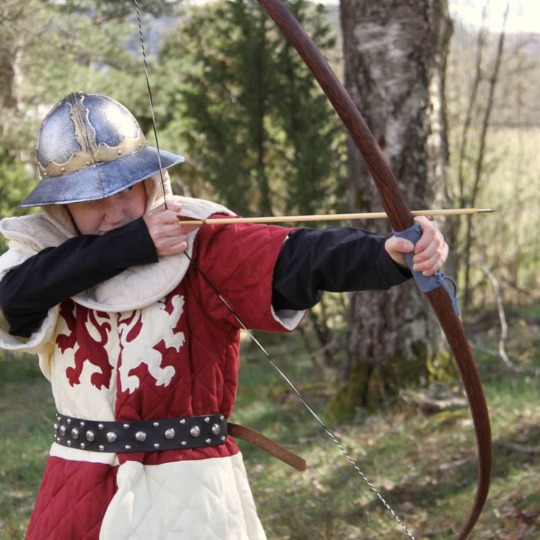

Rhys is stocky and better with a sword, so he balanced a bow and a sword for distance and hand-to-hand combat. He likely used a shield and spear before inheriting his mother’s sword, but he never let go of it once it was his. They were long-bladed weapons, with the curves serving to focus the force of the user’s strength into a smaller area for more damage. They were primarily slashing weapons, with some, like the ones shown below, having a point with a strong two-groove blood-tapestry in the center. There was also a trench knife with a background that was supposed to be taken from a medieval Welsh sword but has more or less been disproven, but there are certainly familiar design elements here too!



Pre-Norman Arthur was younger and smaller but more accurate and was more likely to perch himself somewhere defensible and fire as he ran to give himself time to disapear. His bow was his primary weapon and he probably only had a seax to defend himself for anything too close for the bow until he was older. The Seax is where the Saxon’s got their name and was a very important symbol for freemen to carry, with women often depicted wearing them as well. They were part tool, part sword and could be used as something like a one edged machete. The one here was found in the Thames in the 19th century and was probably from 900 something. The ‘broken back’ shape of the sword is part of where I got my headcanon for Arthur still having back pain from the Viking invasions even 1000 years later. This one was probably way to big for Arthur to have been using and there are much smaller ones but I had to use this one lmao. Lives in my head rent-free.

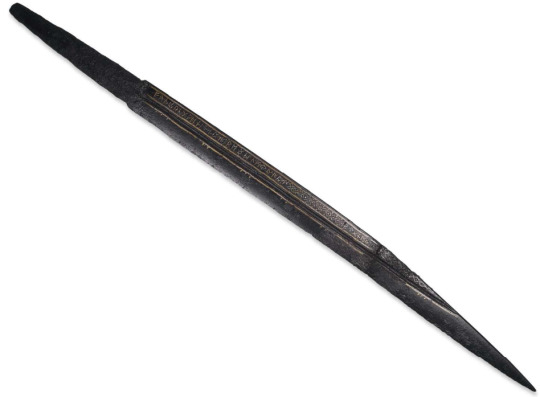
Alasdair always preferred to be at the forge or easel, but where Brighid was usually the head of government, at the foot of their mother's throne, as the firstborn son, he was the acting defender. He was large and did well with a shield and sword, later the broadsword and shield, often wielding the shield with the dirk (Dearg in Scots Gaelic) in the same hand to use if he lost his broad sword. He’s a very tall, broad man, so Claymore isn’t off the table either. He was also very good with an axe. The Scottish version of a poleaxe, the tuagh-chatha, was a semi-moon axe blade on staff and fucking lethal. He could clear a space with that thing, let me tell you. The sword and shield combo is also how he was killed the day their mother died, engaging the Saxons and Jutes who had made it over the bridge before he destroyed it, buying Brighid just enough time to escape across the Irish sea.


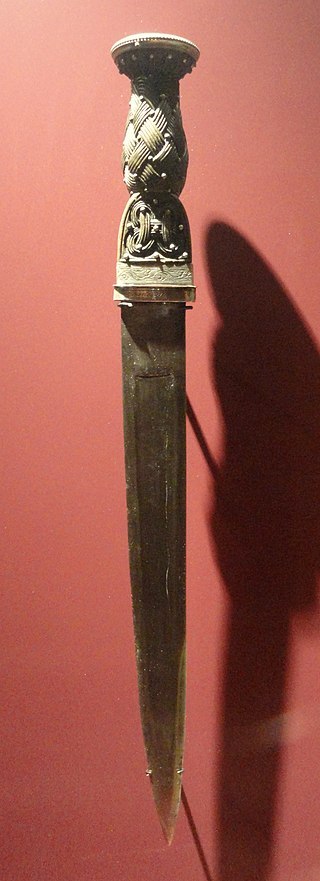
#can you tell how much i liked HEMA when I was a teenage edge lord#the ask box || probis pateo#Alasdair || my heart's in the highlands#Arthur || stone set in the silver sea#Rhys || my word for heaven was not yours#Art History and Aesthetics || our eyes across the ages
47 notes
·
View notes